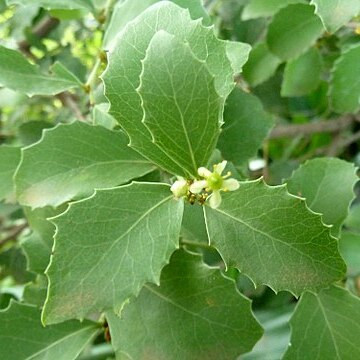Shrub or tree, up to 8 m high. Branchlets angular, with whitish waxy bloom. Leaves alternate, sessile, concolorous, often mottled when dry; lamina elliptic to obovate, (15-)30-50 x 12-30(55) mm, apex acute, rounded to emarginate, base decurrent, often asymmetric, margins glandular-toothed, (3)5-7 teeth on each side, thickened, slightly undulate; midrib and lateral veins prominently raised on both sides. Inflorescences few-flowered, axillary clusters. Flowers whitish; pedicels 7-10 mm long. Sepals ± 1 mm long, margins laciniate. Petals oblong, 3.0 x 1.5 mm long, margins uneven. Stamens ± 2.5 mm long. Ovary 3-locular; style ± 1 mm long, persistent in fruit; stigmas 3. Fruit a 3-valved, obovoid capsule, ± 7 mm in diam., yellow, minutely verrucose. Seeds enveloped by yellow aril.
Shrub, up to 2 m high. Branchlets angular-ribbed, smooth. Leaves alternate, sessile, coriaceous, dark glossy green; lamina obovate or rounded-obovate, unequal, larger ones 20-30 x 14-20 mm, smaller ones 5-15 x 5-9 mm, apex acute, obtuse to emarginate, base decurrent, margins with 1-3(4) coarse serrations on upper half, sometimes entire, margins slightly undulate; venation conspicuous. Inflorescences few-flowered clusters, very shortly pedunculate. Flowers yellow; pedicels ± 1 mm long. Sepals orbicular, ± 1 mm long, margins laciniate. Petals ± suborbicular, ± 2 mm long, margins uneven. Stamens ± 1 mm long. Ovary (2)3-locular. Fruit a (2)3-valved, globose-trigonous capsule, ± 4 mm long, yellow. Seeds enveloped by thin aril.
Leaves not fasciculate, petiolate; lamina pale green or silver-green to dark green and sometimes glossy above, concolorous or sometimes paler below or whitish-glaucous below or on both surfaces, (1·1)3·2–13(20) × (0·9)1·2–7·5(11) cm., ovate or lanceolate or oblong to elliptic or oblanceolate or circular or oblate, acute to rounded at the apex, with margin glandular-denticulate to spinose-dentate or subentire, rarely reflexed or indurated, cuneate-angustate or rarely truncate to subcordate at the base, coriaceous to chartaceous, with 6–9 lateral nerves and reticulate venation varying in density and prominence; petiole 2–8(15) mm. long.
Shrub or tree, up to 10 m high. Leaves with blade ovate, oblong, elliptic to almost circular, 22-130 x 10-90 mm, margin obscurely angled to sharply and spinously dentate or serrate, usually with > 6 teeth on either side, green, greyish green or whitish on lower surface; petiole glabrous; latex threads not visible when leaf is broken. Flowers: small; corolla pale yellow to greenish yellow; Nov.-May.
A large shrub or small tree. It grows 8 m high and the trunk is 70 cm around. It does not have spines nor hairs. The leaves are sword shaped or oval. They taper to both ends. They have blunt teeth. The leaves are 10 cm long by 4 cm wide. The flowers are in tufts. The petals are cream or green. The fruit are round and 5 mm across. They are pale yellow.
Cymes fasciculate, sessile or rarely with peduncle up to 2 mm. long, in axil of foliage leaves; pedicels 2–9(15) mm. long, articulated at the base or in the lower 1/3; flowers 2-c. 30 in each fascicle or rarely solitary, 4–8 mm. in diam., fragrant.
Shrub or tree, up to 10 m high. Leaves green, greyish green or whitish on lower surface, margin obscurely angled to sharply and spinously dentate or serrate, usually with more than 6 teeth on either side. Capsule greenish or whitish to yellow.
Petals white to cream or pale yellow, 1·5–3(5) mm. long, oblong or elliptic to obovate or oblanceolate, sessile or shortly unguiculate, with margin entire or eroded-denticulate, often ± crisped.
Shrub or tree 1·5–10(12) m. high, much branched, sometimes scandent, unarmed, glabrous, without latex, very variable; branches ± markedly lined when young, becoming terete.
Capsule white or pinkish-red to yellow or orange, 4–7(10) mm. long, obovoid to subglobose or 3-gonous, with lobes rounded or carinate, smooth, not fleshy.
Ovary 3-locular, subglobose, c. 1/3-immersed in the disk; style elongate or almost absent; stigma shortly 3-lobed.
Shrub or tree to 10 m. Leaves ovate, toothed. Flowers in axillary fascicles, yellowish. Capsules yellow.
Stamens 5, with filaments 0·7–2 mm. long, not or scarcely flattened, united with the base of the disk.
Disk 5–10-lobed or subentire, flat or with thin free upturned margin or rarely somewhat convex.
Sepals 5, unequal, 0·7–1·5(2) mm. long, ovate to semicircular, rounded, sometimes tinged red.
Seeds orange-brown, completely or almost completely enclosed by an oblique aril.


